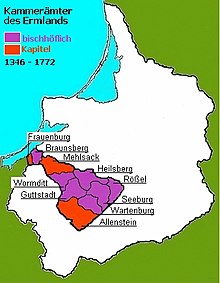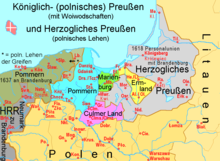Principality of Warmia
The Principality of Warmia ( Polish : Biskupie Księstwo Warmińskie ) was the secular rule of the Bishops of Warmia in their capacity as Prince of Warmia within the Teutonic Order State .
The diocese as such was founded by the papal legate Wilhelm von Modena in the course of the conquest of Prussia by the Teutonic Order (OT) in 1243 ; the title of Prince-Bishop is attributed to Emperor Charles IV . In the late Middle Ages, the secular territory of the bishops also developed.
After the Second Peace of Thorn in 1466, it came to the autonomous Prussia Royal Share , which had voluntarily submitted to the sovereignty of the Polish crown. In the course of the first partition of Poland in 1772, it was secularized and part of the Kingdom of Prussia .
history
With the appointment of Bishop Heinrich I. Fleming in 1278, a special position began to emerge for the Diocese of Warmia. With Heinrich I, only bishops and chapter lords were appointed who did not belong to the Teutonic Order. In this way, the diocese was largely able to withdraw from the rule of the order and gained a sovereign position. The Teutonic Order remained the patron of the diocese, but only took care of external representation, military defense and the right of nomination for some chapter lords. In the Golden Bull of Emperor Charles IV of 1356, the bishop was even listed as imperial prince , a title that was granted to the grand masters of the order only after they had lost their state. The establishment of the town and the granting of town charter by the bishops are to be seen as a sign of independent action, because these measures were carried out in the other dioceses by the Teutonic Order.
Part of the order state
The diocese could only take up its function a few years after its foundation. In the course of the 14th century, the bishop's sovereignty developed over about a third of his diocese . The Teutonic Order, however, continued to have state sovereignty. The bishop was elected by the cathedral chapter, which first met in Braunsberg until an attack by pagan Old Prussians in 1280 , then in Frauenburg . In 1350 Heilsberg became the bishop's residence. The religious center of the diocese (and seat of the cathedral chapter) remained the Frauenburg cathedral .
After the Battle of Tannenberg in 1410, the Prussian bishops paid homage to Władysław II Jagiełło , King of Poland and Grand Duke of Lithuania , but the Teutonic Order was able to maintain its sovereignty for the next few decades. As early as the late Middle Ages there was an effort to appear as imperial prince, and in 1447 the bishop took part in a prince's day of the Holy Roman Empire in Aschaffenburg .
Principality under Polish patronage
During the Prussian City War (1454–1466), Warmia came between the fronts of the rebellious Prussian League, allied with Poland, and the Order. While the cathedral chapter joined the union for a short time, Bishop Franz Kuhschmalz sided with the order; his successor, Bishop Paul von Legendorf , signed a neutrality treaty with the order in 1461, in keeping with the sovereignty of the diocese. The Polish King Casimir IV , who was concerned about the weakening of the order, used this constellation and in 1464 recognized the independence of the diocese. With the 2nd Peace of Thorner of 1466, which sealed the defeat of the order, the Polish king revoked his promises and the diocese was to be placed under Polish rule.
Part of Prussia Royal Share
After the Second Peace of Thorn, the prince-bishopric came to the autonomous Prussian Royal Portion, which was only connected with the King of Poland in personal union . When the Polish King Casimir IV Andreas wanted to derive a right to the appointment of a bishop from this, a conflict arose which is known as the “ Prussian Pfaffenkrieg 1467–1479 ”. The opponent of the Polish king was Nikolaus von Tüngen , elected by the cathedral chapter , who was supported by the Teutonic Order and by King Matthias Corvinus of Hungary .
In the First Treaty of Petrikau in 1479, the Polish king accepted von Tüngen as bishop, while the latter had to confirm the Polish protectorate and instruct the cathedral chapter to only elect candidates proposed by the king. In 1488 the Pope declared that this diocese, founded in Rome and originally directly subject to the Apostolic See, now under the German Concordats, was to be regarded as an excluded one. When von Tüngen died in 1489, the chapter chose Lucas Watzenrode , who was supported by Pope Innocent VIII . This conflict ended in a compromise in 1512: Warmia as a diocese was subordinated directly to the Pope as an exemtes diocese, but the Polish protectorate was confirmed again. The prince-bishopric granted the king the right to propose four candidates, which, however , had to come from Prussia .
After that, the relationship remained relatively stable; the bishops interpreted their position as rulers of the Warmia but still according to the privileges of the Holy Roman Empire . The bishops were Sacrum Romanum Imperi Principis of Varmiensis & Sambiensis and high presidents of the Conventus generalus Terrarum Prussiae , a kind of priority of honor within Royal Prussia. The territory of the Catholic prince-bishopric was enclosed from 1525 by the Protestant Duchy of Prussia , which was elevated to the Kingdom of Prussia in 1701 . The Principality of Warmia was legally equal to a voivodship within the Prussian Royal Share .
In the period that followed, there were political efforts by Poland to transform the personal union into a real union and to integrate Prussia's royal portion more closely into the Polish feudal and imperial union. On the occasion of the establishment of the Union of Lublin on the Lublin Sejm, King Sigismund II incorporated Prussia's royal share as a “province” into the Kingdom of Poland on March 16, 1569. However, the Prussian cities and landed gentry in the area were able to retain many of their traditional rights of autonomy (for example, through a political right of representation in the Sejm, that is, to express their voice and will in the Polish Reichstag).
The territory also had a certain special position in terms of denominational areas in that it was the only part of old Prussia that ultimately remained Catholic . This was not least due to the strong pressure of the Jesuits who came to the country under Prince-Bishop Stanislaus Hosius in 1565.
resolution
As part of the First Partition of Poland , the Duchy of Warmia came under annexation to the Kingdom of Prussia . With the Treaty of Warsaw on September 18, 1773, King Frederick II guaranteed the free practice of Catholic religion, the ecclesiastical property was secularized and placed under the War and Domain Chamber . The exemption was recognized again in 1821 and existed until the 20th century.
Individual evidence
literature
- Hans-Jürgen Karp : Universal Church and Church Particularism in East Central Europe. The exemte dioceses. Diocese of Warmia . In: Dietmar Willoweit , Hans Lemberg (Hrsg.): Reiche und Territorien in Ostmitteleuropa. Historical relationships and political legitimation of power . Oldenbourg, Munich 2006, ISBN 3-486-57839-1 , ( Peoples, States and Cultures in East Central Europe 2), pp. 212–226, excerpt from Google Books .






